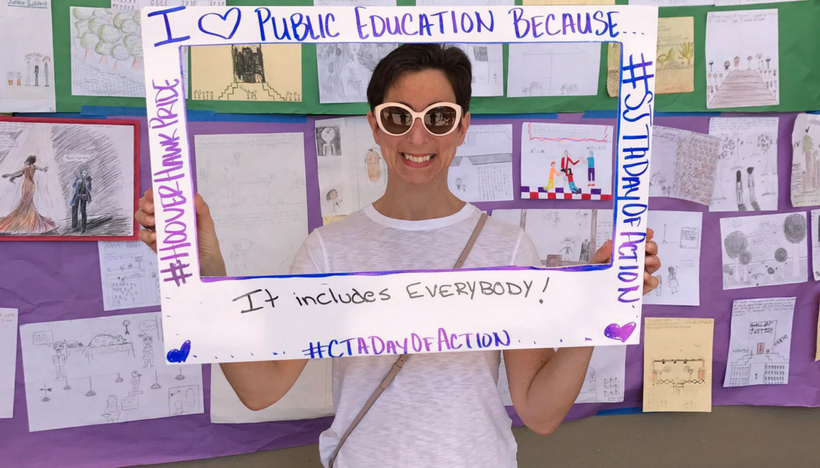This post is written by member Susan Ellenberg.
“Mrs. Ellenberg, you have to run!” exclaimed my middle school students. I had been a social justice educator at a small, independent school for five years when I discussed the possibility of my running for a seat on the San Jose Unified School District’s Board of Education.
Each year I had taught my sixth-, seventh-, and eighth-grade students what it meant to be an engaged citizen: philanthropy, service, activism, political advocacy, ethical spending, and peer modeling. We examined issues of social urgency, looked to see who was working to alleviate those issues, and asked how we could play a role. It occurred to me during a meeting at my daughter’s public school that I needed to model what I was teaching: if I wanted an influential voice in my school district, I needed to engage in the political process of running a campaign and getting elected.
The incumbent was a school board veteran of 22 years, but a proposed district policy that I opposed was enough to resonate with the constituency I would eventually represent. My run began in March of 2014, and I was elected eight months and thousands of phone calls, doors knocked, and dollars raised later. I had never done anything like this but found that I quickly became quite comfortable with the process— I enjoyed meeting voters, learning in-depth about the concerns people had, and discovering what was working well in the district and where growth was warranted. I didn’t even mind asking people to contribute to my campaign because I was convinced that getting into this role would position me to do considerable public good. Large urban school districts like SJUSD are bigger than many city governments, with an annual budget exceeding 300 million dollars. The district’s primary business is education, but we are also in the businesses of physical and behavioral health care, finance, maintenance, groundskeeping, construction, immigrant resources, nutrition, human resources, and energy conservation. Serving on a school board is an honor and a serious responsibility. It is perhaps one of the clearest ways to view all of a city or county’s strengths and challenges in one concentrated environment.
My term began in December 2014, and I got right to work. I imagined I would be able to support my school district’s best efforts to create an environment where all students could succeed. After all, our public schools strive to serve every child who walks through our doors, regardless of their learning needs, emotional challenges, or life circumstances. I was confident that the adults in the district believed in the ability of every child to succeed. And yet . . . .
An opportunity gap had persisted for nearly two decades. I needed to learn quickly why we weren’t having more success, but I found that I wasn’t entirely prepared for what I discovered: when students are struggling, it is often not the result of academic limitations. It is unstable housing, insufficient nutrition, inconsistent health care, and/or lack of access to early childhood educational opportunities.
While a school district plays a vital role in student success, we cannot do the work of ensuring student success entirely on our own. School districts need partners: county agencies that provide safety-net services; community-based organizations that provide supplemental support, instruction, enrichment, and other vital services; and engaged community businesses and individuals who volunteer, mentor, tutor, raise funds, and advocate. If the larger community can ensure that all of its members, including the most vulnerable, have regular access to sufficient nutrition, safe and stable housing, high-quality health care, physical safety, and the opportunity to do meaningful work that will allow for self-sufficiency, all children will succeed in school. This I know to be true.
Despite the existence of these serious societal barriers, my participation on the board has had a measurable impact. My advocacy has led to an extremely progressive family- leave policy for our teachers; the passage of our district’s first parcel tax (with the money designated to support school site teachers and staff); an intensified focus on effective communication; a review and overhaul of the delivery of special education services; and the adoption of policies ranging from gender-neutral bathrooms and protection of undocumented families to free SAT exams for every high school junior. I have been a part of decisions that included the conversion of our transportation fleet to energy-saving buses, the sale and purchase of properties to provide better facilities for students, and the addition of more counseling services for vulnerable students. Our district has a strong relationship with our teachers’ union, and together we have been able to create an evaluation model, supplemented by robust coaching and regular support, that is fast becoming a statewide model.
And yet . . . .The greatest lesson I have learned from my experience is that, while my participation on the school board matters, there are circumstances that impede student success that are far beyond the purview of a school board member. From that I conclude that one of the most important things I can do as a school board member is to reach beyond our district and inspire the entire community—government, private, and nonprofit sectors—to invest in the success of our next generation.
Susan Ellenberg has worked as an attorney, an educator, and a community advocate. She is committed to strengthening her community and ensuring that all children have the opportunity to succeed. Susan currently serves as Vice President of the San Jose Unified School District Board of Trustees

